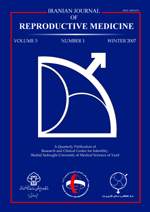
|
International Journal of Reproductive BioMedicine
Research and Clinical Center for Infertility, Shahid Sadoughi University of Medical Sciences of Yazd
ISSN: 1680-6433
EISSN: 1680-6433
Vol. 16, No. 3, 2018, pp. 199-208
|
 Bioline Code: rm18023
Bioline Code: rm18023
Full paper language: English
Document type: Research Article
Document available free of charge
|
|
|
International Journal of Reproductive BioMedicine, Vol. 16, No. 3, 2018, pp. 199-208
| en |
The effect of supernatant product of adipose tissue derived mesenchymal stem cells and density gradient centrifugation preparation methods on pregnancy in intrauterine insemination cycles: An RCT
Fazaeli, Hoda; Davoodi, Faezeh; Kalhor, Naser & Qomi, Reza Tabatabaii
Abstract
Background: One of the most important involved factors in pregnancy occurrence
following intrauterine insemination (IUI) is semen sample preparation. Recently,
supernatant product of adipose tissue derived mesenchymal stem cells (SPAS)
method has been shown to improve semen parameters.
Objective: To compare the effect of preparation methods in order to IUI, SPAS and
density gradient centrifugation (DGC).
Materials and Methods: This trial was done on 80 couples with male factor
infertility who attend jihad daneshgahi infertility treatment center of Qom province,
undergoing ovarian stimulation and IUI cycle. Various semen parameters including
motility, count, DNA fragmentation and capacitation were evaluated before and
after preparation. The effect of semen preparation methods and influence of various
semen parameters on pregnancy occurrence were examined.
Results: The overall clinical pregnancy rate was 17.5% per patient with no
miscarriage. The pregnancy rate for DGC and SPAS were 5% (2 of 40) and 30% (12
of 40) respectively. Since there is no significant difference in improving motion
parameters between two groups (except recovery of total number of motile
spermatozoa), it seems that these parameters alone are not sufficient to predict IUI
pregnancy outcome whereas in samples with >25 million motile spermatozoa in
inseminate, there was a clear trend for a higher pregnancy rate for the sample
processed using SPAS.
Conclusion: Considering SPAS as a new and effective method leading to provide a
combination of various improved semen parameters, is expected in near future.
Keywords
SPAS; Preparation method; Pregnancy; IUI.
|
| |
© Copyright 2018 - International Journal of Reproductive BioMedicine
Alternative site location: http://www.ijrm.ir
|
|
